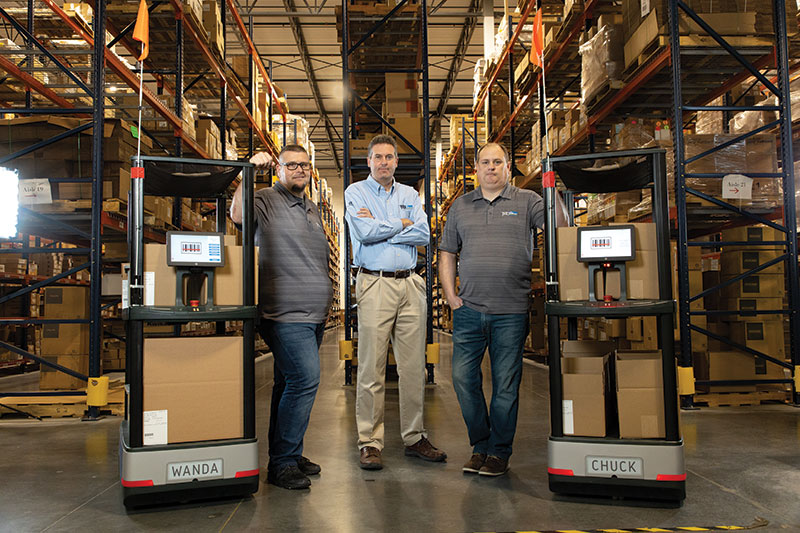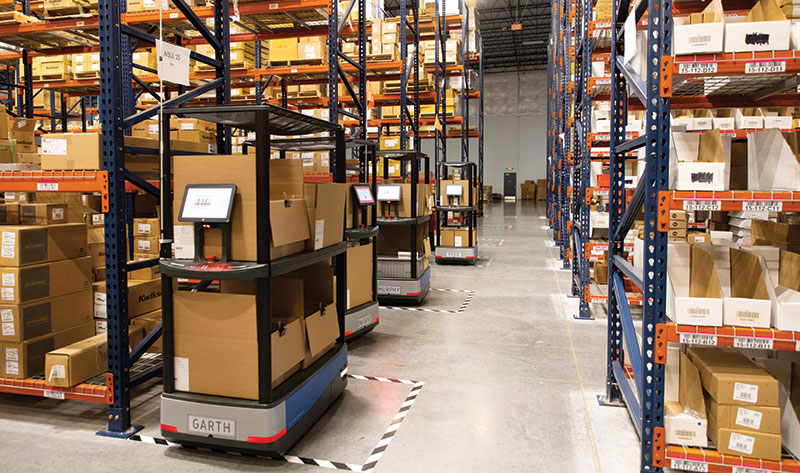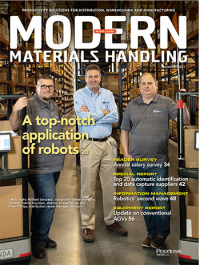A Top-Notch Application of Robots
Top Notch Distributors employed autonomous mobile robots to create safer and more efficient distribution centers.

Not that long ago, less was expected from small to mid-sized companies than their larger counterparts. In part, people understood that they didn’t have the financial resources of the largest companies to invest in technology and high levels of automation or the throughput to justify the investment.
But, two things changed for small to mid-sized distributors. One was the increase in customer expectations driven by e-commerce: When we go online to search for a product, website technology has been democratized to the extent that the websites of the little guys look a lot like the websites of the biggest companies.
To consumers, it all looks the same, so we make decisions based on selection, price and delivery times. Few consumers are willing to wait longer or pay more for a purchase just because it’s from a small company. Now, our experiences as consumers are influencing our work lives. We want the same level of customer service for B2B purchases as for B2C purchases.
Take an in depth look at the systems in place at Top Notch Distribution.
The second has been the decrease in the cost of computing power and technology that has brought goods-to-person and robot-to-goods picking technologies within the financial reach of those small to mid-sized companies. They can now affordably deliver the high levels of service that B2C and B2B customers expect.
Take Top Notch Distributors Inc., a leader in the wholesale distribution of architectural door hardware to residential and commercial dealers with headquarters in Honesdale. Pa. As recently as eight years ago, Top Notch was operating without a warehouse management system (WMS) across its network of four distribution centers. Today, the company is using autonomous mobile robots (6 River Systems) in facilities in Carson City, Nev., and St. Charles, Mo., with plans to introduce autonomous mobile robots (AMRs) in Mansfield, Mass., in 2022. Currently, Top Notch is using nine bots in Nevada and 13 in Missouri. The Missouri facility also features a new rack and conveyor system design and integration (Kuecker Pulse Integration).

“Technology is evolving so quickly and constantly changing,” notes Patrick Houlihan, the director of operations. “But, we saw AMR technology as the best fit for our culture and goals because robotics didn’t replace any employees. AMRs allow our existing employees to do more for our customers without us constantly hiring and training more and more people.”
Houlihan adds that AMRs are addressing three simple but critical issues in Top Notch’s distribution centers. “We’re operating much more efficiently with less labor and in operations that are significantly safer,” he says. “Our employees are able to focus even more on the customer and getting orders fulfilled correctly to our customers’ specifications.”
Mike Strauss, Top Notch’s COO and the executive sponsor of the projects, notes two additional benefits: The ability to add more bots to the existing fleet to meet future growth, and the ease of training new associates on the technology.
“In Missouri, we stock 20,000 unique items,” Strauss says. “It used to take three to six months before a new employee was up to speed on the layout of the facility and understood those different items. Our AMRs are as intuitive as an iPhone. We can bring in someone new, and they’re picking in hours and get to know the facility in a few weeks.”
A focus on service
Top Notch Distributors may fall in that small to mid-sized company category, but it is the leader in the architectural door hardware industry, representing more than 100 market-leading brands of residential, commercial and electronic access control systems.
The company was founded in 1975 by Chuck and Wanda Jurgensen, who worked out of a barn in the rural Northeast Pennsylvania town of Honesdale. They focused on offering customers the best available architectural hardware brands and the “pursuit of excellence in service.”
They knew that by giving their employees the autonomy and authority to do whatever it takes to satisfy each and every customer, it would create customer loyalty. Customer service became the foundation of Top Notch’s mission.
Today, Top Notch offers one- to three-day delivery throughout the United States from four locations. The Missouri facility is the largest at 100,000 square feet, followed by Nevada at 55,000 square feet. Massachusetts—the next facility to get AMRs—is 38,000 square feet. The Pennsylvania DC is 30,000 square feet, but an additional 15,000 square feet is available in another building located across the parking lot. The Massachusetts facility was the result of the acquisition of a Boston-based company five years ago.
In addition to a wide selection of product, Top Notch offers customization and value-added services. For example, they will rekey locks for a dealer who orders a number of doorknobs for a job before shipping. That way, the customer doesn’t have to spend time and resources rekeying on the jobsite. “Our employees know our customers and our products,” Houlihan says. “It’s difficult for us to use a lot of temps because an employee needs to understand what they’re picking off the shelf.”
Up until eight years ago, the facilities were conventional and rudimentary, but not uncommon. Top Notch didn’t have a WMS to speak of or bar code-directed picking—orders were picked to carts from paper. Storage and picking were from a centralized area and picking from the top levels of a rack or shelf often meant going up and down rolling ladders. Employees often walked 7 miles a shift.

With growth, and the challenge of finding warehouse labor, that approach was no longer sustainable. “A lot of our processes were simplistic pick, pack and ship,” says Strauss. “But we wanted to build the commercial side of our business, which is a more complex product portfolio with a lot of customizable options for customers.”
The company began to optimize its processes in 2015. One of the first steps was to implement a new enterprise resource planning (ERP) system with a new WMS that would allow further integration with modern platforms. Employees still picked from paper, but they could scan products at putaway and picking to get more accurate inventories.
In addition, says Houlihan, they worked on identifying the most popular items and moving those to the floor level to make operating safer, reduce ladders and clear warehouse congestion. A short stretch of conveyor that diverts items to a value-added processing area and to shipping followed. Today, an area is designated to automatically add dunnage and then tape and label an outgoing parcel. Finally, weighing and cubing technology enabled the WMS to recommend the right box for an order.
The conveyor and packing automation addressed a bottleneck related to shipping. But, with 20% annual growth “we never had enough people to staff the business,” says Houlihan, “so we had to keep bringing in and training new people.”
An analysis of the greatest wastes of labor in the facilities identified walking and climbing ladders. A re-slotting initiative eliminated ladders by bringing items closer to the ground level. The facilities also feature case-flow near the conveyor system for the fastest-moving items. But order selectors were still walking 7 miles a shift to pick to carts.

Investigating robots
In 2019, Top Notch began to investigate picking technologies. Houlihan says the company had several goals for the next project:
- Better space utilization and storage optimization;
- Create a safer and more ergonomic working environment, including eliminating ladders to the extent possible;
- Improve efficiency through reduced employee travel; and
- Create a foundation to enable the company’s strategic growth plans. Up to that point, the capacity of the facilities was a hurdle to realizing growth goals.
The company did investigate some alternative solutions to AMRs, including an automated goods-to-person solution, voice picking, light-directed picking, putwalls, conveyor and smart carts.
According to Strauss, the internal considerations included the capital investment required to implement and deploy those solutions, the operational benefit each could provide over the next five to 10 years and the cultural impact on associates, or the change management that would be required to deploy and operate the solutions.
A team from Top Notch met with 6 River Systems in Chicago at ProMat in April 2019. They also had a chance to visit a 6 River customer in the Chicago area to see the system in action. When compared to the alternatives under consideration, AMRs seemed the best fit. “Our business model is old-fashioned wholesale distribution. We buy in bulk and receive pallets,” explains Brian Phillips, manager of the Missouri facility. Phillips, who had experience running large, highly automated distribution centers, was part of the team at ProMat. “At least 80% of our business is case picking. 6 River was the best suited for case handling.”
Another selling point, according to Strauss, occurred during a visit to a 6 River customer in New Jersey. “The gentleman who gave us the tour took us down to the floor and had us pick,” Strauss recalls. “With zero training, we were following the robots and picking live orders within 10 minutes. That was a powerful experience.”
Top Notch worked with 6 River for more than a year to fit AMR technology to Top Notch’s processes and integrate with its IT systems. Over that time, “our operations and IT teams visited multiple sites and had the chance to speak with others using their technology,” says Houlihan. “Their analysts visited our locations, and we shared data and information with them to make sure this was a good fit.”
Once the decision was made to go forward, the goal was to go live in March 2020. Then, Covid intervened.
First Nevada, then Missouri
The project got underway in May. Between March and May, Top Notch and 6 River teams worked remotely to build the API and integrate the systems. Similarly, when the robots arrived in Carson City, 6 River gave the Top Notch maintenance team remote instructions on how to set them up.
The Nevada facility went first because Top Notch was in the midst of moving into a new 100,000-square-foot distribution center in Missouri. It was a slow rollout that took about three weeks because of Covid, according to Houlihan. “We had to quarantine about a third of our warehouse staff for a brief time due to a Covid scare, including the onsite consultant from 6 River, but we continued to work remotely during that period,” Houlihan says.

According to Mike Saraceno, manager of the Carson City distribution center, minimal prep work was needed to get the facility ready to work with the robots. Some new electrical panels were installed to handle the power requirements for rapid charging, some striping was put down to create parking spots for the robots and an aisleway was created for induction on the conveyor, for instance.
They also developed a process to prep the carts with the shipping boxes required for orders so associates could begin picking as soon as the carts were deployed. Last, perhaps, was prepping the associates for the introduction of a new technology. “We held a number of meetings and showed them how the robots worked with videos,” Saraceno recalls. “By the time the robots arrived, they were confident it was going to make things run more smoothly, and they were eager to begin working with them.”
Another selling point to the staff: No one was laid off as a result of the robots. Instead, they allow the facility to grow its business without growing its staff.
Within a few days of receiving the robots, productivity was nearly 25% ahead of where it had been and within a month of 6 River’s trainer leaving, the facility was exceeding the projected numbers.
The Nevada facility laid the groundwork for going live in Missouri when the new facility was ready to operate in the fall of 2020. Brian Phillips, the St. Charles DC manager, says that in fairly short order, order selectors had doubled their picking rates with AMRs.
Today, he says employees are walking about 3 miles a shift compared to 7 miles before, and the facility has tripled its former picking rates. He adds that his best order selectors can pick as much as four times the previous average.
“If we have a busy day where our orders increase by 25%, we can handle it with one additional person in picking, where we would’ve added two or three in the past,” Phillips says. “There are goods-to-person technologies that will get significantly more lines per hour than we are picking, but those rates aren’t necessary for our operations.”
About three months into the implementation, Phillips made a change to the process that has since been adopted by the Nevada facility. 6 River software receives orders from the WMS and then optimizes the pick path based on the work it has to execute. Phillips’ team realized the robots were more efficient when they had a large batch of orders to analyze.
So, they began postponing picking until later in the day. That was one factor in improving efficiency. A second was using more than one robot to pick large orders. As an AMR completes its task, it delivers its load to a consolidation station where boxes are staged until the entire order is ready for completion.
Finally, Phillips notes that 6 River is now essentially the WMS for the facility, adding that the dashboard is providing analytics he didn’t have before, such as the productivity of individual order selectors, how many orders are being worked on at any given moment in time or estimates of how much labor will be required to fill a batch of orders.
Looking forward
Many companies are using Robotics-as-a-Service to lease their fleets. Top Notch bought its fleet of nearly 20 robots. “Given low interest rates and our assumptions on the operating life of the carts, buying them made the most sense for our operations,” says Strauss.
With more than a year of experience, Top Notch is exploring ways to leverage the investment. For one, they are exploring the use of the fleet for replenishment. Another potential change: With higher picking rates, labeling is now a potential bottleneck, so Top Notch is exploring whether it can label shipping boxes before picking as part of the cart prep process.
Both Strauss and Houlihan credit their ongoing relationship with 6 River as a key to their success with AMRs. “We have weekly calls with them, even if it’s just a few minutes to check in,“ says Strauss. “It’s been a tremendous partnership.”
They both credit the quick training time for new associates in a very tight labor market as one of the benefits AMRs have brought to their operations. AMRs have also positioned the company for growth. “We’re operating more efficiently with less labor in operations that are significantly safer,” says Houlihan. “And, we’re capable of scaling for more growth in the years to come.”
Take a more in depth look at the systems in place at Top Notch Distribution.

Article Topics
Automation News & Resources
Walmart chooses Swisslog AS/RS and software for third milk processing facility Lucas Watson appointed CSO for Körber’s Parcel Logistics business in North America 60 Seconds with Bob Trebilcock, outgoing executive editor, Modern Materials Handling Kathleen Phelps to join FORTNA as chief financial officer Coles automates grocery distribution in Australia 2024 Intralogistics Robotics Survey: Robot demand surges Warehouse automation extends life of cheese DC by a decade More AutomationLatest in Materials Handling
The (Not So) Secret Weapons: How Key Cabinets and Asset Management Lockers Are Changing Supply Chain Operations MODEX C-Suite Interview with Harold Vanasse: The perfect blend of automation and sustainability Consultant and industry leader John M. Hill passes on at age 86 Registration open for Pack Expo International 2024 Walmart chooses Swisslog AS/RS and software for third milk processing facility NetLogistik partners with Vuzix subsidiary Moviynt to offer mobility solutions for warehouses Materials Handling Robotics: The new world of heterogeneous robotic integration More Materials HandlingAbout the Author
Subscribe to Materials Handling Magazine

Find out what the world's most innovative companies are doing to improve productivity in their plants and distribution centers.
Start your FREE subscription today.
April 2024 Modern Materials Handling

Latest Resources











